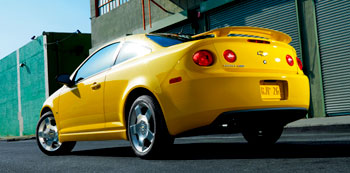LOOKING FOR A PREVIOUS STORY? CHECK THE ARCHIVE.
GM Sets Sail on
$859-Million Cruze
$859-Million Cruze
Long-time truck and SUV titan GM is shifting gears, rolling out a big push for small cars. And the company's first fuel-friendly offering, the Cruze compact, will be built at a 5,000-employee Ohio plant that was once a candidate for the chopping block.
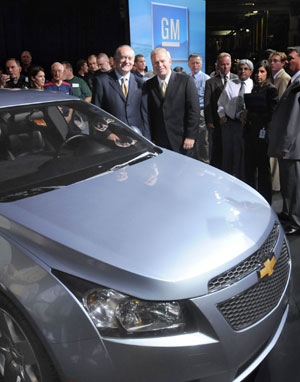
Ohio Lt. Gov. Lee Fisher (left) and Gov. Ted Strickland (right) stand by a just-unveiled prototype of the new Chevy Cruze at GM's Lordstown plant.
Photos: Chris Kasson, Ohio Department of
Development, unless otherwise noted
Development, unless otherwise noted
H
anging a hard left turn in the sputtering North American market, General Motors is ponying up a hefty US$853 million to drive the launch of the small-scale Chevrolet Cruze. That new "global compact" is a central cog in GM's strategy to hitch more of its flagging fortunes to fuel-efficient vehicles – de-emphasizing the gas-guzzling trucks and SUVs that have long been the automaker's bread and butter.
The Cruze initiative arrives in the midst of GM's drive to slash $10 billion in North American costs by 2010. But despite the company's hard-core economizing and its industry-record $38.7-billion loss in 2007, the new model's North American incarnation won't be made in Mexico. Instead, with major assists from a revamped labor pact and $84 million in state incentives, the company has just announced that it's investing $350 million to build the Cruze at GM's massive complex in Lordstown, Ohio, about 60 miles (97 kilometers) southeast of Cleveland.
That 5,000-employee, five-million-sq.-ft. (450,000-sq.-m.) Ohio operation had been hanging in limbo since late last year. The sprawling Lordstown plant, which first went online in 1966, was one of the biggest bargaining chips in GM's 2007 negotiations with the United Auto Workers. Now, with the Cruze, the facility is positioned on the crest of the company's latest shot at rejuvenation.
"The Cruze is part of our accelerated focus on more fuel-efficient vehicles," GM CEO Rick Wagoner told the crowd of about 600 people inside the Lordstown plant on Aug. 22. "In fact, 18 of our next 19 new vehicles will be cars or crossovers."
GM's $350-million outlay at the Ohio plant, he explained, will retool the operation to make the Cruze, a compact that will carry a large chunk of GM's hopes for a rebound.
"The Cruze will be the first in a family of compact Chevrolets," Wagoner noted. "Our goal for the Cruze is to lead in fuel economy in this very competitive car segment."
On paper, at least, the new-breed Chevy could be a fuel-efficiency contender.
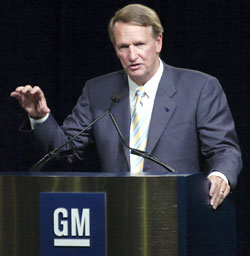
GM CEO Rick Wagoner describes the company's plans at the Lordstown plant.

A rendering of the Chevy Volt, a plug-in hybrid vehicle powered by electricity and gas that will also be among GM's new small car offerings.
Image: GM
But GM has revealed few specs on the Cruze, which won't make its public debut until the 2008 Paris Motor Show that begins on Oct. 4th. GM officials have allowed, however, that the Cruze marks only the first step in the company's shift of its product mix to 60 percent cars and 40 percent trucks and SUVs. GM's current blend is 50/50.
"With fuel prices higher, I think people's value equation is changing," Wagoner explained in Lordstown. "We think the change in consumers' minds is structural. The opportunity to get a more balanced profit portfolio, large vehicle to small vehicle, is going to arise in the U.S. and be more like it is in the rest of the world."
Lordstown Plant Exhales
• $359 million to retool a Flint, Mich., plant to build the 1.4-liter Ecotec engine that will power the Cruze and Chevy's new battery-driven Volt – an investment that will retain 300 jobs.
• $150 million to develop and market the Cruze for its future U.S. roll-out in 2010.
Before the Cruze emerged, though, the future that awaited the Lordstown facility had been upsettingly murky. The 5,000-worker operation had been a plant without a product.
Ben Strickland, shop chairman for Lordstown's UAW Local 1112, recalled a dispiriting meeting that he and other North American leaders had with the union's leadership.
"That was not a good meeting," Strickland said from the podium in Lordstown. " 'It looks like we are going to lose the small car to Mexico,' [they said]. That did not happen. They said we couldn't step up to the plate. Well, we stepped up to the plate, we got what we deserve, and we're going to continue to get what we deserve."
"The Lordstown union and GM have a very cooperative and productive relationship," Steve Schoeny, director of the Ohio Department of Development's (DOD) Strategic Business Investment Division, tells the SiteNet Dispatch from Columbus. "Without that relationship, the conversation about making the Cruze at the Lordstown plant doesn't ever start."
The announcement of the Cruze's assembly in Ohio ends months of speculation about the Lordstown plant's possible shutdown.
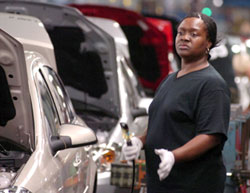
GM's 5,000 workers at the Lordstown plant spent months wondering what kind of future was waiting for them down the line.
The scenario didn't begin to clear until seven months later. GM in early June announced a restructuring that in 2010 will shutter four plants in Janesville, Wis.; Moraine, Ohio; Oshawa, Ontario; and Toluca, Mexico. Employing about 9,100 workers, those four facilities all make trucks and SUVs.
But GM in June also announced that it was adding a third Lordstown shift of 1,400 workers in August – the first clear sign that the huge facility would likely survive. (The company also added a third shift at Orion assembly plant in Michigan to build more Chevy Malibu and Pontiac G6 midsize sedans.) But the future of the Lordstown plant didn't solidify until Wagoner's Aug. 21st trip – the GM CEO's first visit to the big plant.
"It's essential that we at GM respond quickly and comprehensively to the world's demand for new, more fuel-efficient vehicles," Wagoner said shortly before a foam model of the Cruze was unveiled. "And we at GM have decided that Lordstown is the exact right place to build the all-new Cruze."
Despite the months of headed-to-Mexico buzz, the atmosphere at the Cruze announcement had a strong red-white-and-blue tinge. As the Ohio audience waited for the proceedings to begin, piped-in music included "Livin' in the USA" and "R.O.C.K. in the USA."

Steve Schoeny, director of the Ohio Department of Development's Strategic Business Investment Division
New Labor Pact Helped Make
U.S. Expansions Financially Feasible
"We started talking to GM in the spring of last year about possibly bringing a new product to the Lordstown plant," Schoeny explains. "They told us right up front that getting any new product depended on having the right kind of labor agreement. And when we were working with them, they would occasionally tell us, 'We need to pull back from this for a little while to focus on those areas first and work on the new labor agreement.' "
The final agreement that came out of the GM-UAW talks contains one dominant labor concession: The UAW agreed to take health-care benefits for GM's 400,000 retirees and their dependents off the automaker's books. Instead, those benefits will be paid out by a $61.9-billion voluntary employee beneficiary association (VEBA), a trust fund that the UAW will oversee. GM is obligated to contribute up to $29.9 billion to that VEBA.
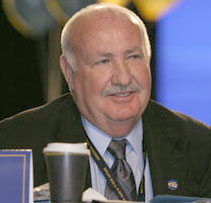
"With my assignment lately, there's not been a lot of good news," UAW Vice President Cal Rapson acknowledged in Lordstown.
"With my assignment lately, there's not been a lot of good news," UAW Vice President Cal Rapson acknowledged in Lordstown. "But this is a good day for me.
"Some of the things we did with the last contract were somewhat controversial," Rapson continued. "But there was never a doubt in my mind that it was the right thing to do. The trade-off was a commitment to product. And one of the commitments was to come right here in Lordstown."
The new UAW contract has also lowered the Ohio plant's labor costs. The new agreement establishes a two-tier system of wages and benefits, a precedent-setting provision for a UAW contract. Roughly 1,000 of the Lordstown plant's recently hired workers are now making about $14 an hour. That's about half of the wages of workers who signed on under previous UAW contracts.
State's $84M in Incentives Call
For Keeping Plant Open for 30 Years
Specifically, GM's operation in northeast Ohio is getting a 15-year, 75-percent Job Retention Tax Credit. In return, GM is obligated to keep 3,700 employees at the Lordstown site for the next 30 years.
"Obviously, the incentives were clearly important in helping GM make the business case for building the Cruze in the U.S.," says Schoeny. "But it was more than incentives alone that prompted GM to select Lordstown for making the Cruze."
In addition to the state's cooperative labor-management climate, Ohio bolstered its attractiveness to manufacturers like GM with the state's 2005 tax reform.
"That reform has been a huge help in attracting capital-intensive projects," Schoeny asserts.
The state's 2005 reforms included eliminating the tax on tangible personal property, phasing out the corporate income and franchise taxes, and phasing in a commercial activity tax that's based only on sales within Ohio.
That revamped tax climate has helped stimulate GM to invest $2 billion in its Ohio facilities over the past four years, says Schoeny.
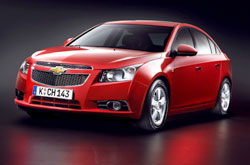
A GM rendering that demonstrates the Cruze's body style.
The Cruze, though, is definitely the GM product – and project – of the moment.
Landing the assembly of one of the automaker's pivotal small car products ends many months of uncertainty for the Lordstown plant's 5,000 workers. At the same time, the new work assignment comes with its own stern challenge, with North American automotive demand at its weakest ebb in years.
"Our confidence in the car is good," Wagoner said at the Cruze announcement in Lordstown. "Our confidence in the market is not so good right now. Obviously, it's pretty weak."
| CONTINUE TO THE LATEST EDITION OF “TOP INCENTIVES DEAL” | |
| RETURN TO: SITESELECTION.COM
|
LOOKING FOR A PREVIOUS
STORY? CHECK THE ARCHIVE.
|
 PLEASE
VISIT OUR SPONSOR • CLICK ABOVE
PLEASE
VISIT OUR SPONSOR • CLICK ABOVE 
Site
Selection Online
©2009 Conway Data, Inc.
All rights reserved. Data is from many sources and is not warranted
to be accurate or current.
